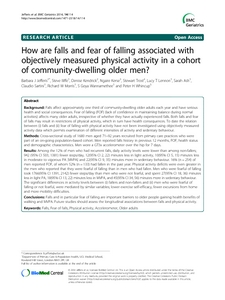Jefferis, BJ;
Iliffe, S;
Kendrick, D;
Kerse, N;
Trost, S;
Lennon, LT;
Ash, S;
Sartini, C;
Morris, RW;
Wannamethee, SG;
et al.
Jefferis, BJ; Iliffe, S; Kendrick, D; Kerse, N; Trost, S; Lennon, LT; Ash, S; Sartini, C; Morris, RW; Wannamethee, SG; Whincup, PH
(2014)
How are falls and fear of falling associated with objectively measured physical activity in a cohort of community-dwelling older men?
BMC Geriatrics, 14 (114).
ISSN 1471-2318
https://doi.org/10.1186/1471-2318-14-114
SGUL Authors: Whincup, Peter Hynes
![[img]](https://openaccess.sgul.ac.uk/107233/1.hassmallThumbnailVersion/How_are_falls_fear_falling.pdf)  Preview |
|
["document_typename_application/pdf; charset=binary" not defined]
Published Version
Download (243kB)
| Preview
|
Abstract
BACKGROUND: Falls affect approximately one third of community-dwelling older adults each year and have serious health and social consequences. Fear of falling (FOF) (lack of confidence in maintaining balance during normal activities) affects many older adults, irrespective of whether they have actually experienced falls. Both falls and fear of falls may result in restrictions of physical activity, which in turn have health consequences. To date the relation between (i) falls and (ii) fear of falling with physical activity have not been investigated using objectively measured activity data which permits examination of different intensities of activity and sedentary behaviour.
METHODS: Cross-sectional study of 1680 men aged 71-92 years recruited from primary care practices who were part of an on-going population-based cohort. Men reported falls history in previous 12 months, FOF, health status and demographic characteristics. Men wore a GT3x accelerometer over the hip for 7 days.
RESULTS: Among the 12% of men who had recurrent falls, daily activity levels were lower than among non-fallers; 942 (95% CI 503, 1381) fewer steps/day, 12(95% CI 2, 22) minutes less in light activity, 10(95% CI 5, 15) minutes less in moderate to vigorous PA [MVPA] and 22(95% CI 9, 35) minutes more in sedentary behaviour. 16% (n = 254) of men reported FOF, of whom 52% (n = 133) had fallen in the past year. Physical activity deficits were even greater in the men who reported that they were fearful of falling than in men who had fallen. Men who were fearful of falling took 1766(95% CI 1391, 2142) fewer steps/day than men who were not fearful, and spent 27(95% CI 18, 36) minutes less in light PA, 18(95% CI 13, 22) minutes less in MVPA, and 45(95% CI 34, 56) minutes more in sedentary behaviour. The significant differences in activity levels between (i) fallers and non-fallers and (ii) men who were fearful of falling or not fearful, were mediated by similar variables; lower exercise self-efficacy, fewer excursions from home and more mobility difficulties.
CONCLUSIONS: Falls and in particular fear of falling are important barriers to older people gaining health benefits of walking and MVPA. Future studies should assess the longitudinal associations between falls and physical activity.
Statistics
Item downloaded times since 20 Jan 2015.
Actions (login required)
 |
Edit Item |



